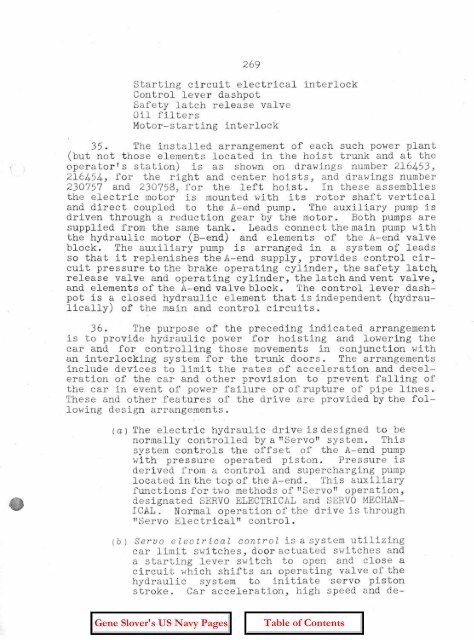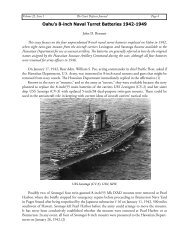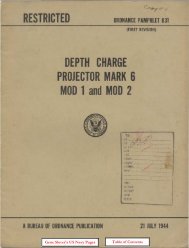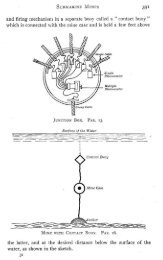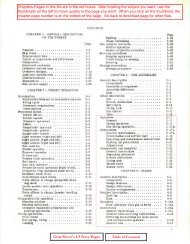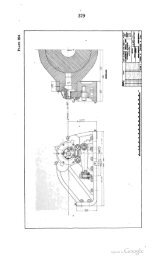OP-755 Part 2 Pages 197-401 - Personal Page of GENE SLOVER
OP-755 Part 2 Pages 197-401 - Personal Page of GENE SLOVER
OP-755 Part 2 Pages 197-401 - Personal Page of GENE SLOVER
You also want an ePaper? Increase the reach of your titles
YUMPU automatically turns print PDFs into web optimized ePapers that Google loves.
269<br />
Starting circuit electrical interlock<br />
Control lever dashpot<br />
Safety latch release valve<br />
Oil filters<br />
Motor-starting interlock<br />
35. The installed arrangement <strong>of</strong> each such power plant<br />
(but not those elements located in the hoist trunk and at the<br />
operator! s station) is as shown on drawings number 216453,<br />
216454, for the right and center hoists, and drawings number<br />
230757 and 230758, for the left hoist. In these assemblies<br />
the electric motor is mounted with its rotor shaft vertical<br />
and direct coupled to the A-end pump. The auxiliary pump is<br />
driven through a reduction gear by the motor. Both pumps are<br />
supplied from the same tank. Leads connect the main pump with<br />
the hydraulic motor' (B-end) and elements <strong>of</strong> the A-end valve<br />
block. The auxiliary pump is arranged in a system <strong>of</strong> leads<br />
so that it replenishes theA-end supply, provides control circuit<br />
pressure to the brake operating cylinder, the safety Latch,<br />
release valve and operating cylinder, the latch and vent valve,and<br />
elements <strong>of</strong> the A-end valve block. The control lever dashpot<br />
is a closed hydraulic element that is independent (hydraulically)<br />
<strong>of</strong> the main and control circuits.<br />
36. The purpose <strong>of</strong> the preceding indicated arrangement<br />
is to provide hydrau-lic power for hoisting and lowering the<br />
car and for controlling those movements in conjunction with<br />
an interlocking system for the trunk doors. The arrangements<br />
include devices to limit the ra tes<strong>of</strong> acceleration and de-celeration<br />
<strong>of</strong> the car and other provision to prevent falling <strong>of</strong><br />
the car in event <strong>of</strong> power failure or <strong>of</strong> rupture <strong>of</strong> pipe lines.<br />
These and other features <strong>of</strong> the drive are provided by the following<br />
design arrangements.<br />
(a) The electric hydraulic drive is designed to be<br />
normally controlled by a "Servo" system. This<br />
system controls the <strong>of</strong>fset <strong>of</strong> the A-end pump<br />
with pressure operated piston. Pressure is<br />
derived from a control and superCharging pump<br />
loca ted in the top <strong>of</strong> the A-end. This auxiliary<br />
f'unct Lons for two methods <strong>of</strong> ftServo!! operation,<br />
designated SERVOELECTRICALand SERVOMECHAN-<br />
ICAL. Normal operation <strong>of</strong> the drive is through<br />
ftServo Electrical!! control.<br />
(b) Servo electrical control is a system utilizing<br />
car limit switches, door actuated switches and<br />
a starting lever switch to open and close a<br />
circui t which shifts an operating valve <strong>of</strong> the<br />
hydraUlic system to initiate servo piston<br />
stroke. Car acceleration, high speed and de-


